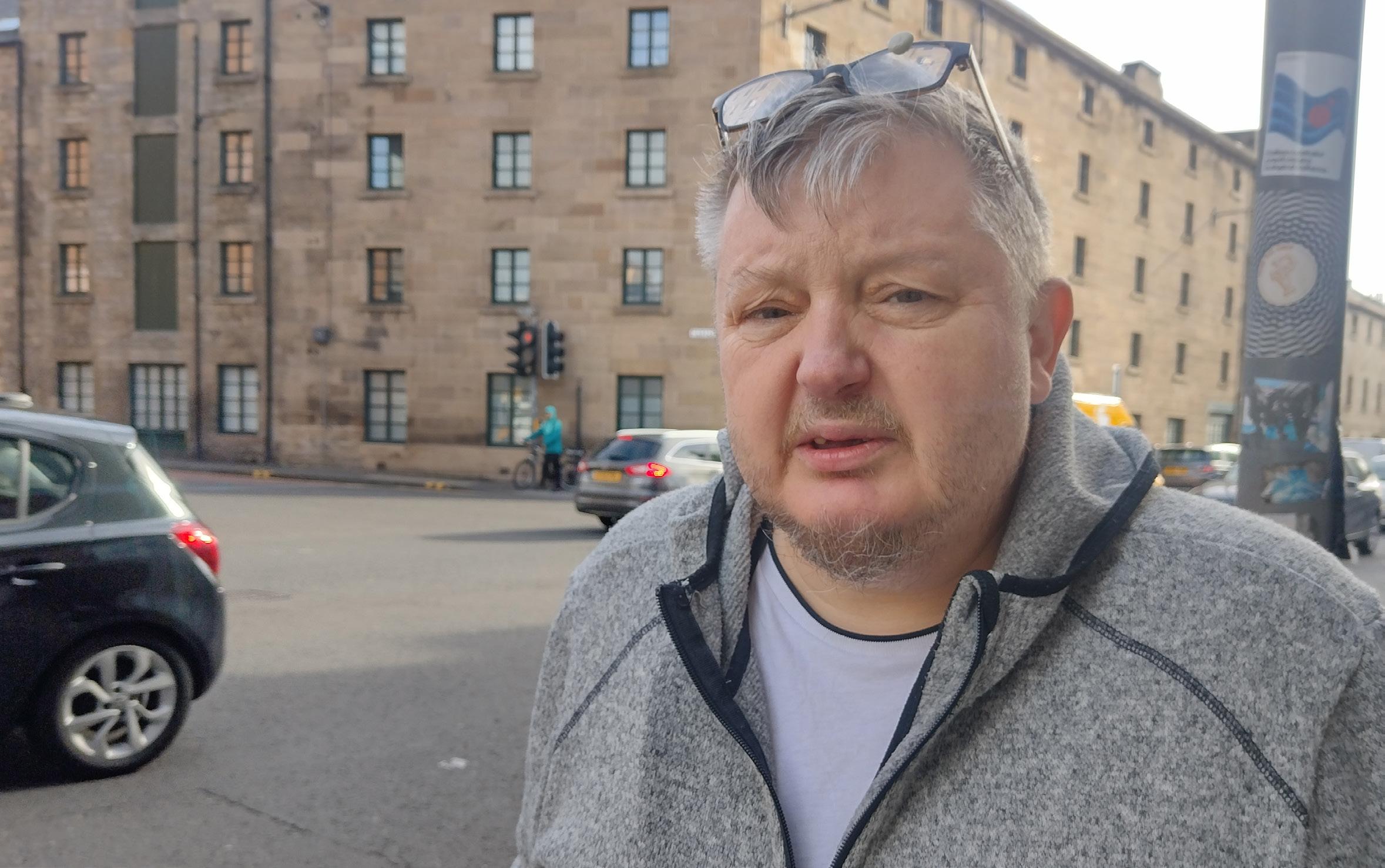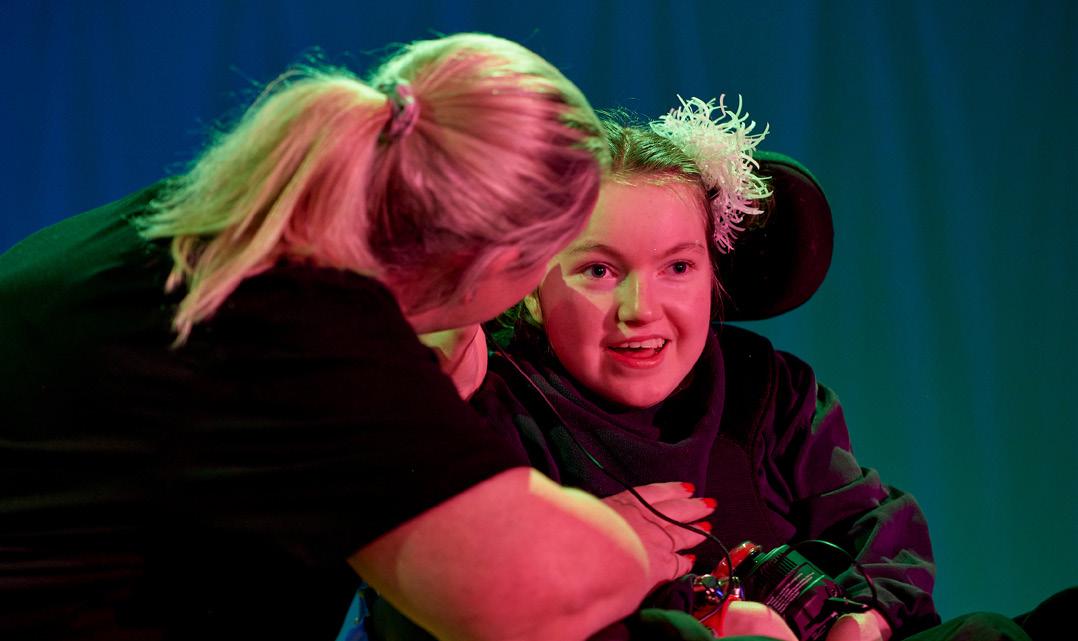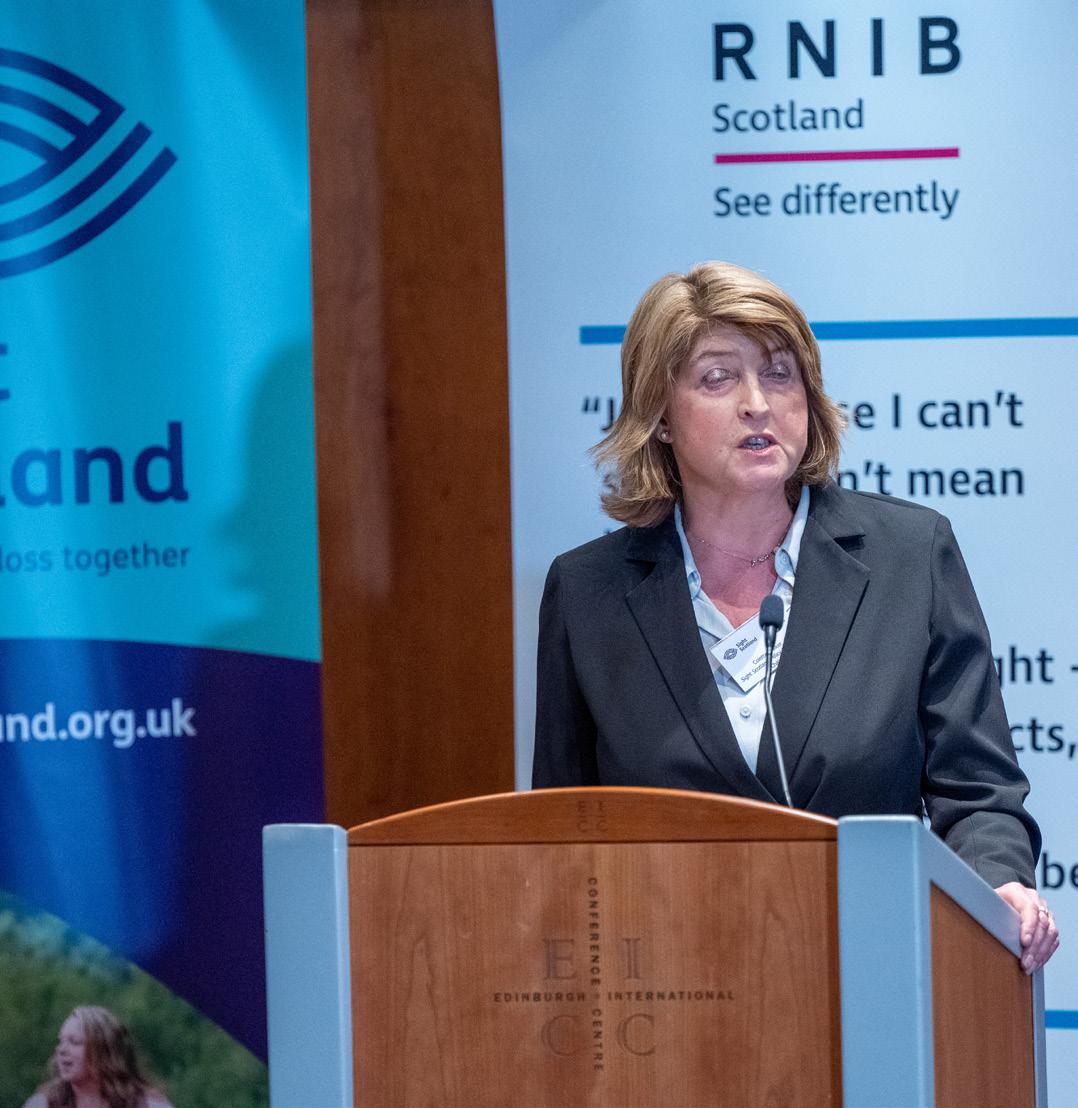Energised to help anyone with sight loss

February 2023 | sightscotland.org.uk
Page 4
Page 6 Christmas
Page 12
In this issue: Lee’s story
Being a Sighted Guide
show
Welcome to our first iSight edition of 2023. I hope you and your family are keeping warm and cosy this winter.
We know keeping active is so important for everyone’s mental health and wellbeing. Sight loss can affect people’s confidence and leaving the house to exercise can be a scary thing. The good news is, our Community service is here to support people to keep active and mobile. On page 4, you can read about Lee. Our Rehabilitation and Mobility team taught Lee to use a long cane, and now he’s out walking his dog and visiting the swimming pool again. You can support someone with sight loss to keep active too. On page 6, we have an introduction to being a sighted guide.
Christmas might seem like a distant memory but we thought you would love to see the fantastic photos from the Royal Blind School’s Christmas show on page 12. The show was great fun for all. Finally, we offer a warm thank you to everyone who donated towards our Christmas appeal. We are in the process of seeing exactly what we can buy thanks to our readers’ generous support. Keep an eye on our social media where we will
announce everything we were able to provide for the school thanks to the appeal.
Thank you, I hope you enjoy reading your iSight magazine.
Davina Shiell Director of Marketing and Communications

Did you know?
In Scotland, 111,000 people are estimated to be living with diabetic retinopathy, a sight loss condition associated with diabetes. You can learn more about diabetic retinopathy on page 16 (Reference: RNIB Sight Loss Data Tool, June 2022).
iSight in alternative formats To receive iSight in large print, braille or audio CD please contact us on 0131 229 1456 or email fundraising@sightscotland.org.uk

Sight Scotland is the operating name of The Royal Blind Asylum and School. Scottish Charity Number SC017167
Address: Sight Scotland, 2A Robertson Avenue, Edinburgh EH11 1PZ

02
Dear Supporter
Support Line Talk to us on 0800 024 8973 Now open 9am to 5pm, Monday to Friday Welcome
Celebrating 230 years!
This year, we are proud to celebrate Sight Scotland’s 230th anniversary! Our charity has changed so much since we started 23 decades ago. Here are some key moments in our history:

1793: Our charity is founded. A founding member, Reverend Dr David Johnston, held collections for the charity at his church.

1875: Our educational unit amalgamates with The School for Blind Children at Craigmillar Park, Edinburgh, which was founded in 1835.


1891:
1915: We establish a second charity, the Scottish National Institution for Blinded Sailors and Soldiers (now known as Sight Scotland Veterans) to support servicemen returning to Scotland from World War One who were blinded by mustard gas.
1991: The Royal Blind School’s campus in Morningside opens as a purpose-built school for pupils with multiple disabilities as well as visual impairment.

2010: Forward Vision opens, providing 24-hour personalised care for young adults with visual impairment and additional disabilities.


We have kept evolving for 230 years, because we don’t just see blindness. We see far beyond this. Today we are Sight Scotland and Sight Scotland Veterans, two sister charities with one shared history and one mission. Together we see a world where anyone with vision loss is empowered to live a fulfilling life. We see hope, courage, opportunity. Thank you for seeing as we see.
2021: Our freephone Support Line (0800 024 897) launches.
You can learn at sightscotland.org.uk/about-us/our-history
03
Commercial braille production begins at Craigmillar Park. The service concentrates on producing religious and educational materials in braille.
230 years
Lee’s story
Lee says that thanks to our Community Service’s support, he’s now able to get out of his house and live his life again.
Lee is 50 years old and lives in Leith, Edinburgh. Lee has diabetic retinopathy and cataracts in both eyes, which means the lenses in his eyes have cloudy patches.
Lee said: “My vision is misty. For example, I can’t see what’s in this sandwich in front of me. I’d often stay at home, because it was hard getting across the road.”
Seeking help, Lee called our Sight Scotland Support Line.
Our Rehabilitation and Mobility Officer, Caroline Hedley, met with Lee and assessed the challenges his visual impairment was having on his everyday life.

Lee said: “Caroline recommended several lights for me, which make it easier to see in my house. She also suggested coloured chopping boards, and it’s been a great help.”
To help increase Lee’s mobility, Caroline taught him how to use a long cane over a six-month period.
Lee
04
Sight Scotland has made a big difference to my daily life. Without learning how to use this cane, I couldn’t get about.”
-
Community
Lee said: “We did eight training sessions at the Ocean Terminal shopping centre and then did training near where I live. Finally, I did training at the Edinburgh Botanical Gardens and I used the cane to find my way along the path.

“I now use the cane whenever I leave the house. I used to walk into the bollards on the footpath near home, because when it’s dark, you can’t see them. The cane helps me negotiate them and get home.”
“I’m always out now. I don’t like being stuck in the house. Normally, I’ll take my dog up to Ferry Road for a walk. I’ve got a train pass, which allows me to take trains anywhere in Scotland. So, I can go to Fife on the train and take my dog for a walk on the beach. She absolutely loves it.”
Lee said he was hugely grateful for the support.
“I go swimming… I love swimming. I’ve even started going to the gym now.
“Sight Scotland has made a big difference to my daily life. Without learning how to use this cane, I couldn’t get about.
“From the bottom of my heart, I’d like to thank Sight Scotland and all the people that have helped me. I appreciate the help, I really do.”
More information
Lee has a condition called diabetic retinopathy. You can learn more about this condition on page 16 and don’t forget, if you know anyone who may benefit from the support of our team, they can call us on 0800 024 8973.
05
Community
Do you know how to be a Sighted Guide?
Our Rehabilitation Officer Marie (pictured) gives tips on how you can help a friend, neighbour or family member with sight loss get about.
What is a Sighted Guide?
This is when a person offers their arm to help someone with visual impairment to travel safely from point A to B or from one location to another.
Why is a Sighted Guide important?
A sighted guide empowers the guided person to be in control of their walking pace and the direction of travel, to be aware of obstacles, and to reach their chosen destination safely and confidently.
How do I become a Sighted Guide?
In this article, we look solely at the basics of supporting someone with sighted guiding. However, a full sighted guide training session would also include going through doorways, finding a seat, getting in and out of a vehicle, changing which side you are guiding from, and ascending or descending stairs.

A Sight Scotland Rehabilitation and Mobility Officer can provide sighted guide training to you, your family, and your friends, carers or colleagues. You can call our Rehabilitation and Mobility Line on 0131 285 7488.

What are the Sighted Guide techniques?
1. Check if assistance is required
It’s a good idea to ask the person with visual impairment if they would like to be guided. If yes, ask which arm they wish to be guided by.
2. Stand beside and slightly ahead of the person being guided Face the same direction, and the person being guided should be half a step behind the guide.
06 Get involved
3. Guide with your arm
The person being guided should hold on to the back of the guide’s upper arm, just above the elbow. The guide should keep their arm relaxed and close to their body.

5. Indicate when
the path narrows
If the guide approaches a narrow passageway, the guide should move their elbow behind their back. This indicates to the guided person that they should follow behind the guide, in single file.

4. Give information and warnings
The guide should verbally announce upcoming obstacles and hazards, and changes in direction or walking speed. For example, “We will turn left around a corner soon” or “We are about to pass through a narrow gap”. The guide can also describe the walking surface, such as, “There is a cobbled street ahead of us, which we’ll step on to soon”.
More information
Would you like more information about supporting someone with sight loss?
You can call our Rehabilitation and Mobility Line on 0131 385 7488.

07
Get involved
Dot’s story
impacted
sight
sight loss themselves.
Dot Wilson contacted our Community team after her mother-in-law was diagnosed with Macular Degeneration.
Dot says her mother-in-law has gained a great deal of confidence and independence since receiving support and advice from the team. Here is Dot’s experience, in her words…
“As we were a bit in the dark about where to find help, I gave the Sight Scotland Support Line a call. Debbie, who is a Community Worker at Sight Scotland, was fantastic, giving me a few hints and tips on where to get help and what we could do.”

Two years ago, my mother-in-law started to have issues with her vision. Eventually, she got a diagnosis of Macular Degeneration [MD]: wet MD in one eye, and dry in the other.”
“Two years ago, my mother-in-law started to have issues with her vision. Eventually, she got a diagnosis of Macular Degeneration [MD]: wet MD in one eye, and dry in the other.
“It was a dreadful experience for her, as she had to go into the consultation, and received the shocking outcome, alone. She was then hurried out of the hospital before she could gather her thoughts. So distressing, especially in front of her grandchildren.
08
Community
It is crucial that family members and friends of people
by
loss receive support, as well as those experiencing
Making changes to support independence
Dot writes… “As I have learned, it’s really important for the person affected to be in control, and to go at their pace, but also to allow family and friends to help in some way.
“The first issue was that my mother-in-law couldn’t see the weeds in the garden, so she called upon all the family, including the grandchildren, to help change it to an easy management garden (you can always get someone to cut grass, but it’s a challenge to get someone to weed). Hard work and mucky, but quite fun!
“She has also been upfront with friends and neighbours that she is not seeing so well, and they have been very supportive. I am very proud of her taking this action, as I know it was difficult, but has helped her feel less isolated.
“I went online and bought some “bump-ons”, as I could see that they would be useful. I said I would pop them in her ‘bits and bobs’ drawer, until she felt it was time for them to be used. A few weeks later, they appeared on the oven as she could no longer see the numbers.

“And I’ve gone on to share some of the knowledge gained. At a recent event, I met with a lady, whose husband is losing his sight, and won’t ask for help. I carry a few of the small leaflets with the Sight Scotland Support Line number on them, just in case! She was relieved that there was someone she could speak to.”
We are delighted that Dot and her family are making so many fantastic adaptations to deal with the impacts of sight loss. If someone you know is experiencing changes to their sight, you can call our Support Line for information and advice: 0800 024 8973
You can help us be there
Thanks to support from donors, we were able to be there for Dot and her motherin-law. If you are able to make a donation, please visit sightscotland.org.uk/donate
09
Community
She has also been upfront with friends and neighbours that she is not seeing so well, and they have been very supportive.”
Thank you for your support!
A huge thank you to all our amazing supporters who donated throughout 2022. Thanks to you we have been able to provide equipment, support, care and a summer house!



10
Thank you
Innowalk exercise machine
Rompa interactive dance mat
Musical equipment for Royal Blind School pupils



11 Thank you
Smile DriveDeck Brand new TMX Tricycle
Summer House at the Forward Vision garden
Royal Blind School Christmas show

Royal Blind School pupils and teachers performed a colourful and multi-sensory show in December, which told the story of a Snow Queen and a teenage rock band determined to bring back the seasons. The show was great fun and enjoyed by performers and audience alike.




12
Learning





13 Learning
Securing positive change for people with visual impairment
We engage in policy development to take forward our aim of securing positive change for people with visual impairment. We believe it is vital that decision makers at every level are aware of the needs and experiences of people with visual impairment when they make key decisions.


Raising issues with decision makers
In the past year, we had exhibition stalls at several political party conferences. We advocated for people with visual impairment in consultation responses on the National Care Service and on The Disability Commissioner for Scotland Bill.
In October 2022, we met with the Minister for Transport, Jenny Gilruth MSP. We discussed the progression of our Fair Rail campaign, calling for free companion travel on trains for those who hold an NEC card with the eye +1 symbol. We’re now in discussions with Transport Scotland about our proposal and how to take this forward.
Sparking discussions about the future of visual impairment education
With 80 per cent of learning through vision, children and young people with visual impairment start at a disadvantage to their peers. It is crucial we continue improving the learning opportunities for children with visual impairment.
14
Influencing change
In November 2022, we teamed up with RNIB to host a seminar on the future of visual impairment education in Scotland. An open panel discussion gave glimpses into the experience of Royal Blind School pupil Samantha Gough (pictured), and the views of several Qualified Teachers of children with Visual Impairment (QTVIs). We also heard from a parent, Colette Walker (pictured), who shared her journey of accessing suitable education for her son who has visual impairment, while living with visual impairment herself. Colette’s son attended the Royal Blind School and is currently in our adult residential services.

Colette said: “He passed them (exams) and excelled in maths, he loved French and music – he plays piano. And it was all done in braille. So, you do need that specialised education for the likes of Ciaran.
“He likes education. He enjoys education. And he should be entitled like all of us, as a human right, to go in and be educated.”
Amplifying the voices of people with visual impairment
In July 2022, we started our new Sight Loss Champions policy group, which involves those with visual impairment in policy work. Two members of the seven-person group, Colette and Matthew, are pictured here.

Our Sight Loss Champions are a central part of our policy campaign design team. They contribute to an annual policy plan, attend conferences, and act as spokespeople. Sight Loss Champions also receive training to develop their skills and confidence.
In 2022, our Champions shared their opinions in evidence sessions on town planning and accessibility at Glasgow City and the City of Edinburgh councils.
More information
We are so excited for what our Sight Loss Champions can achieve this year! For more information, please email policy@sightscotland.org.uk
15
Influencing change
What is diabetic retinopathy?
Diabetic retinopathy is one of the leading causes of sight loss in the United Kingdom among people of a working age (1). It is a diabetes complication and occurs when high blood sugar levels damage the retina, which contains lightsensitive cells at the back of the eye responsible for receiving and organising visual information (2). If undiagnosed and untreated, diabetic retinopathy can cause severe sight loss (3).
How common is diabetic retinopathy?
Diabetic retinopathy can develop in anybody with type 1 or type 2 diabetes. It can affect up to 80 per cent of people who have had diabetes for 10 years or more (4).
In Scotland, 111,000 people are estimated to be living with diabetic retinopathy. Of those 111,000 people, it is estimated that 10,200 individuals are living with a severe form of the condition (5).

What are symptoms of diabetic retinopathy?
In its early stages, diabetic retinopathy tends not to have any obvious symptoms. People do not usually notice it until it becomes more advanced. Early signs of the condition can be picked up by taking photographs of the eyes during diabetic eye screening. Everyone with diabetes who is 12 years old or over is invited for an annual eye screening (3).
People with diabetes should contact their doctor if they experience any of the following:
• gradually worsening vision
• floating shapes in their field of vision
• patchy vision
• eye pain and redness.
16
Sight loss conditions
Sight loss conditions
What treatments are available?
Managing your diabetes is the best course of action to minimise the risk of the condition. If screening detects significant problems meaning someone’s vision is at risk, the main treatments for advanced diabetic retinopathy are:
• laser treatment
•injections of medication into your eyes
•an operation to remove blood or scar tissue from your eyes.
Research into diabetic retinopathy
Sight Scotland and our sister charity Sight Scotland Veterans fund ophthalmology research through the Royal College of Surgeons in Edinburgh.
To better understand diabetic retinopathy, we funded a study that follows patients undergoing a conversion to insulin pump therapy. This research examines whether changes in patients’ retinopathy relate to changes in their glucose control.
Following this, NHS Lothian modified its practice. Patients now have a retinal eye screening when they begin their insulin pump therapy, and again after three months. This screening stage allows for intervention which might save people’s eyesight.
References
(1)RNIB.org.uk
(2) Mayo Clinic.org
(3) NHSinform.scot
(4) Moorfields.nhs.uk
(5) RNIB Sight Loss Data Tool, June 2022.
17
Research we support We fund research into several sight loss conditions. You can find out more at sightscotland.org.uk/how-we-help/research
A fundraising hero
People have the most wonderful ways of fundraising!
Continuing a family tradition, Stewart Cromar built a series of colourful toilet roll dolls. For a modern twist, he built the toilet roll dolls out of Lego pieces.
Stewart said: “For those unfamiliar with a toilet doll, these are traditionally crocheted or knitted figures that discreetly cover the spare toilet roll in your bathroom.
“Both my Grans (Peggy and Millie) used to raise money for their local churches by making kitsch toilet dolls, and I’m keen to continue this cherished family tradition in their honour.”
Stewart ran a raffle on justgiving.com for one of his colourful toilet dolls – the raffle was a great success, raising more than £1,281 for Sight Scotland!


It’s not the first time Stewart has raised funds with his creations, either. In 2021, the Lego fan raised funds by building a model of the University of Edinburgh Library.
Stewart, who is impacted by visual impairment himself, said he finds making Lego structures a great help to his physical and mental health.
Thank you Stewart! We are so grateful for your efforts.
More information
sightscotland.org.uk/get-involved
18
You can take on a fundraising challenge too! For ideas, you can visit
Fundraising
MasterCard Visa CAF Charity Card Card No: - -Expiry Date: / Security code: Name on card: Signature: Please collect my payment on the 1st or 15th of every month (please tick your preferred date). Name and full address of your Bank/Building Society: To: The Manager Bank / Building Society Address: Postcode: Name(s) of Account Holder(s): Bank / Building Society Account Number Branch Sort Code -Service User Number 2 5 1 7 0 9 Reference (for office use only) Instruction to your Bank or Building Society Please pay Sight Scotland Direct Debits from the account detailed in this Instruction subject to the safeguards assured by the Direct Debit Guarantee. I understand that this Instruction may remain with Sight Scotland and, if so, details will be passed electronically to my Bank/Building Society. Banks and Building Societies may not accept Direct Debit Instructions for some types of account. Signature(s): Date: / / Please return to the Sight Scotland, NOT to your bank. We will confirm your new regular donation details by letter. Giving a regular gift to Sight Scotland helps us plan ahead with confidence, which is vital to us reaching and supporting more people with sight loss across Scotland. I would like to make a monthly gift of £3 £5 £8 Or my choice of £____ Yes, I want to change the lives of people with sight loss Please fill in your details below: 1. I would like to give a one-off gift of: Here is my donation of: £12 £22 £54 or my own choice of £ I enclose a cheque or voucher made payable to Sight Scotland OR please debit my card: 2. I would like to make a monthly gift Or Title: Forename: Surname: Address: Postcode:
3. My Gift Aid
Make your donation worth 25% more with Gift Aid. If you are a UK tax payer, we can reclaim 25p for every £1 you donate – just tick the box below.
Yes, I am a UK tax payer and I would like Sight Scotland to reclaim tax on all donations I have made in the past 4 years or will make in the future until I notify you otherwise. I understand that if I pay less Income Tax and / or Capital Gains Tax than the amount of Gift Aid claimed on all my donations in that tax year it is my responsibility to pay any difference. Please notify us if you want to cancel this declaration, change your name or home address or if you no longer pay sufficient tax on your income and / or capital gains.
4. Communications preferences
Please let us know if we can continue to communicate about our work, progress and future needs so that together we can ensure everyone in Scotland with sight loss has someone to turn to.
Please contact me by phone. My number is:
Please contact me by email. My address is: We’re committed to keeping your details safe, and we will never sell them. Raising funds is crucial to our work, but if you’d prefer not to receive fundraising communications from us, please email us at privacy@sightscotland.org.uk You can see how we protect and use your personal data in our privacy policy at sightscotland.org.uk/privacy
Your continuing support means so much to people with sight loss
Across Scotland, thousands of people living with sight loss have no one they can turn to for help. But by giving a precious gift today, you can offer hope and transform lives. We have several projects we are actively fundraising for. If you would like your donation to go to a specific campaign, please select below.
Where my donation is most needed
The Family Wellbeing Service and Support Line











































